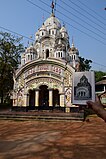
Chandrakona is a town and a municipality in the Ghatal subdivision of Paschim Medinipur district in the state of West Bengal, India. The city is located between Ghatal and Garhbeta. Chandraketu was the founder of the kingdom of Chandrakona. In the Ain-E-Akbari, the 16th century Mughal document, it was mentioned as ‘Mana’.

Khirpai, also known as Kshirpai, is a city and a municipality in the Ghatal subdivision of the Paschim Medinipur district in the state of West Bengal, India. Earlier it was part of Hooghly. The city is situated between Ghatal and Chandrakona, near the banks of the rivers Shilabati and Kethai, and is one of the oldest municipalities in India. Khirpai is also famous for its Babarsa, a special type of sweetmeat, which is not available elsewhere.

Ramjibanpur is a city and a municipality in the Ghatal subdivision of the Paschim Medinipur district in the Indian state of West Bengal.

Kharar is a historical town of Ghatal and one of the oldest town in Asia. This city is located in the Ghatal Subdivision of the Indian state of West Bengal. Earlier this town was part of Hooghly District later it was merged with Medinipur district.
Daspur is a village, with a police station, in Daspur I CD Block in Ghatal subdivision of Paschim Medinipur district in the state of West Bengal, India. Previously a part of Hooghly District, later in 1872 it was merged with Medinipur district.

Narajole is a village and gram panchayat in Daspur I CD Block in Ghatal subdivision of Paschim Medinipur district in the state of West Bengal, India.

Gourangapur is a village in Kanksa CD block in Durgapur subdivision of Paschim Bardhaman district in the Indian state of West Bengal. The place has links with Ichhai Ghosh, king of Gopbhum, and it is believed that his capital, Dhekur, was located nearby. The area was earlier a part of Senpahari pargana.

Ichhai Ghosher Deul is located near Gourangapur in the Indian state of West Bengal. It is a late mediaeval brick-built temple of the sikhara type without any image. Tradition says that Ichai Ghosh constructed the temple in honour of the Goddess Bhagabati. However, this type of brick temple seen at Neiba Khera, Uttar Pradesh.
Pathra is a village and a gram panchayat in the Midnapore Sadar CD block in the Medinipur Sadar subdivision of the Paschim Medinipur district in the state of West Bengal, India.

Chandrakona Jorbangla Temple is a 17th-century stone built temple at Dakshinbazar, Chandrakona in Ghatal subdivision of Paschim Medinipur district in West Bengal, India.
Shantinatha Shiva Temple is a nava-ratna temple, built in 1828 at Mitrasenpur, Chandrakona in Ghatal subdivision of Paschim Medinipur district in West Bengal, India.
Malleswara Shiva Temple is a pancha-ratna temple, built in the 18th century at Chandrakona in Ghatal subdivision of Paschim Medinipur district in West Bengal, India.
Karnagarh is a village and a gram panchayat in the Salboni CD block in the Medinipur Sadar subdivision of the Paschim Medinipur district in the state of West Bengal, India.
Laoda is a village in the Daspur I CD block in the Ghatal subdivision of the Paschim Medinipur district in the state of West Bengal, India.
Dihi Baliharpur is a village in the Daspur I CD block in the Ghatal subdivision of the Paschim Medinipur district in the state of West Bengal, India.
Gobindanagar is a village in the Daspur I CD block in the Ghatal subdivision of the Paschim Medinipur district in the state of West Bengal, India.
Lachhipur is a village in the Ghatal CD block in the Ghatal subdivision of the Paschim Medinipur district in the state of West Bengal, India.

Bengal temple architecture also known as Malla dynasty architecture is about temple styles developed and used in Bengal, particularly the chala, ratna and dalan temples.
Jayantipur is a village in the Chandrakona II CD block in the Ghatal subdivision of the Paschim Medinipur district in the state of West Bengal, India.

Ratna Style is a style of Bengal temple architecture, that originated in Bengal from the 15th to 16th centuries, under the Mallabhum kingdom. Originating as a regional style in Hindu temple architecture. It is an extended style of the Chala temple. The special feature of Ratna-style temples is the curved cornice of the chala.
















